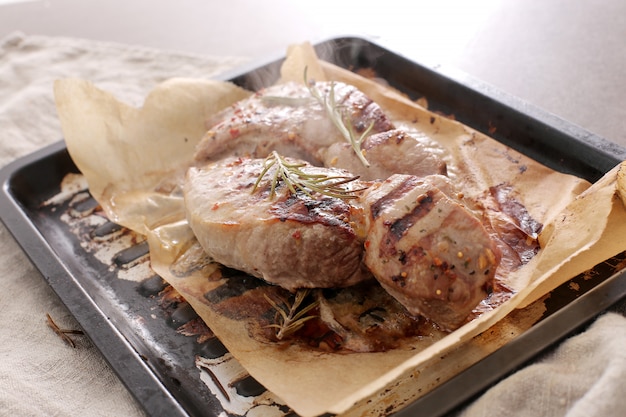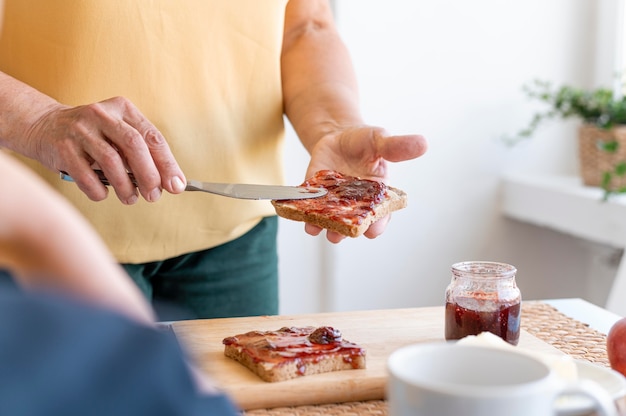Let's face it, there's nothing quite like a juicy, perfectly cooked bone-in pork chop. It's a classic comfort food that always hits the spot, whether you're having a family dinner or just a quick meal for one. But getting the cooking time right can be a bit of a puzzle, right? I've definitely had my fair share of dry, overcooked pork chops in the past. It's not a pleasant experience, let me tell you! That's why I've made it my mission to master the art of cooking bone-in pork chops to juicy perfection.
Over the years, I've experimented with different methods, temperatures, and timings, and I've finally cracked the code. In this guide, I'll share all my secrets to ensure you can consistently cook delicious bone-in pork chops every single time. So, grab your apron, gather your ingredients, and get ready to embark on a culinary adventure with me!
(Part 1) The Magic of Bone-In Pork Chops

Let’s start with the star of the show – the bone-in pork chop. Why the fuss over bone-in, you ask? Well, there are a few reasons why I prefer them over boneless pork chops:
1. Flavor Booster
The bone adds an incredible depth of flavor to the pork chop. It's like a secret ingredient that makes the meat taste so much more robust. As the chop cooks, the bone releases flavorful juices that infuse the meat. It's truly a game-changer in terms of taste. Imagine the difference between a roast chicken cooked with the bone in versus one cooked boneless. It’s the same principle! The bone imparts a rich and savory flavour that you just can’t get with boneless cuts.
2. Juicier Results
The bone acts as a natural barrier, preventing the meat from drying out during cooking. It helps to retain the moisture, resulting in a more succulent and juicy pork chop. This is especially crucial when cooking thicker chops, as they can be more prone to overcooking. The bone essentially acts as a heat shield, ensuring the meat cooks evenly and doesn't dry out on the edges.
3. The “Wow” Factor
Let's face it, bone-in pork chops just look more impressive on the plate. They have a rustic charm that adds a touch of elegance to any meal. Plus, it's fun to gnaw on the bone and savor the last bits of flavour! I think it elevates the whole dining experience. It’s a bit of a conversation starter too – people just seem to appreciate the effort and care that goes into cooking a beautiful bone-in chop.
(Part 2) Understanding the Different Cuts

Not all pork chops are created equal. They come in different thicknesses and cuts, and each requires a slightly different cooking approach. Here's a breakdown of the most common cuts:
1. center cut Pork Chops
These are the most popular type of pork chops. They come from the loin, which is a leaner section of the pig. They're usually about 1 inch thick and have a good amount of fat marbling, making them juicy and flavorful. I’d say these are a perfect starting point for beginners, as they’re quite versatile. They cook up quickly and evenly, making them ideal for pan-frying, grilling, or baking.
2. Rib Chops
Rib chops come from the rib section of the pig. They're typically thicker and more flavorful than center cut chops, with a more substantial bone. They can be a bit more challenging to cook, but the result is well worth the effort! They’re ideal for slow cooking methods like braising. The rich marbling and the flavour of the rib section combine to create a truly decadent pork chop.
3. Sirloin Chops
Sirloin chops come from the sirloin, which is a leaner and tougher cut of meat. They're usually thinner than other types of pork chops and require shorter cooking times. They can be a bit more dry, so it's important to cook them properly to avoid overcooking. I find these are great for grilling or pan-frying. A quick sear can create a delicious crispy crust while keeping the interior moist. They’re also a good option for using in recipes like pork chop stir-fry.
(Part 3) The Art of Temperature and Time

Now that you have a grasp on the different types of pork chops, let's talk about the crucial element of cooking: temperature and time. This is where the magic happens, ensuring a juicy and tender pork chop.
1. The internal temperature
To ensure safe and delicious pork chops, we need to cook them to an internal temperature of 145°F (63°C). This is the safe minimum temperature to kill harmful bacteria. I always keep a meat thermometer handy to make sure my pork chops are cooked through. Don't rely solely on visual cues, as they can be misleading! The meat can appear cooked on the outside, but still be undercooked on the inside. A meat thermometer is your best friend!
2. The Timing Game
Here's where things get a bit tricky. Cooking time can vary depending on the thickness of the pork chop, the cooking method, and your preferred level of doneness. A good rule of thumb is to allow 4-6 minutes per side for a 1-inch thick bone-in pork chop. For thicker chops, increase the cooking time accordingly. If you're unsure, it's always better to err on the side of caution and cook for a little longer. You can always check the internal temperature with your thermometer.
3. The “Resting” Ritual
Once your pork chops are cooked, let them rest for 5-10 minutes before carving and serving. This allows the juices to redistribute throughout the meat, resulting in a more tender and flavorful chop. It's like a mini-spa treatment for your pork chop! The resting time gives the muscle fibres a chance to relax and absorb the juices, making for a much more succulent and enjoyable eating experience.
(Part 4) Cooking Methods Unveiled
Now, let’s dive into the exciting part - the various ways to cook your perfect bone-in pork chops. Each method has its own unique benefits and flavour profiles, so it’s all about finding your favourites.
1. Oven-Baked Delights
Oven baking is my go-to method for achieving juicy and tender pork chops. It's incredibly easy, hands-off, and allows you to cook multiple chops at once. Preheat your oven to 375°F (190°C) and place the seasoned chops on a baking sheet. Bake for about 20-25 minutes, or until the internal temperature reaches 145°F (63°C). For a crispy crust, you can broil the chops for a couple of minutes at the end. The oven's even heat ensures that the pork chops cook evenly, resulting in a tender and juicy interior.
2. Pan-Frying Power
Pan-frying is a quick and efficient method for cooking pork chops. It creates a beautiful sear and crispy crust. Heat some oil in a cast iron skillet over medium-high heat. Once the oil is hot, add the seasoned chops and cook for about 4-6 minutes per side, or until golden brown and cooked through. I often add a knob of butter towards the end to create a richer flavour. This is a great method for making a quick and satisfying meal. The high heat creates a beautiful caramelized crust, while the shorter cooking time ensures the chop retains its moisture.
3. Grilling Glory
Grilling brings a smoky, charred flavour to pork chops that’s truly irresistible. Preheat your grill to medium-high heat and place the seasoned chops on the grill. Close the lid and cook for about 5-7 minutes per side, or until cooked through. You can use a meat thermometer to check the internal temperature. Be careful not to overcook, as grilled pork chops can dry out easily. The smoky flavour of the grill adds a unique dimension to the pork chops, making them perfect for outdoor gatherings.
4. Slow Cooking Magic
Slow cooking is a great way to create incredibly tender and flavorful pork chops. It's perfect for thick cuts or if you want to cook the chops in a sauce. Season the chops with your favorite ingredients and place them in your slow cooker. Cook on low for 6-8 hours, or until the meat is tender and falling off the bone. You can also add vegetables, herbs, and spices for extra flavour. The slow cooking process breaks down the tough muscle fibers, resulting in an incredibly tender and flavorful pork chop. It’s a great option for a hands-off meal.
(Part 5) Seasoning Your Way to Success
The right seasonings can transform a simple pork chop into a culinary masterpiece. Here are some of my favorite flavour combinations:
1. Classic Herb and Spice
A simple blend of salt, pepper, garlic powder, onion powder, paprika, and thyme adds a classic, comforting flavour. This is my go-to seasoning for everyday pork chops. It's versatile and complements a variety of cooking methods. I like to rub this blend directly onto the pork chops, making sure to get all the nooks and crannies. The combination of herbs and spices creates a well-rounded flavour that enhances the natural taste of the pork.
2. Italian Inspiration
For a Mediterranean twist, try a blend of oregano, basil, rosemary, garlic powder, salt, and pepper. This combination creates a fragrant and flavorful pork chop that's perfect for serving with pasta or roasted vegetables. I often add a drizzle of olive oil and a squeeze of lemon juice for a touch of acidity. The combination of herbs evokes the flavors of Italy, adding a bright and fresh element to the dish.
3. Asian Fusion
A blend of soy sauce, ginger, garlic, sesame oil, and chili flakes adds a bold and aromatic flavour to pork chops. It's perfect for stir-fries or serving with rice. You can also use a pre-made Asian marinade for an easy and delicious option. The mix of soy sauce, ginger, and garlic creates a savory and pungent flavour that's both complex and addictive.
(Part 6) side dishes Galore
No pork chop feast is complete without the perfect side dishes. Here are some of my favourite pairings that complement the flavour of pork chops beautifully:
1. Starchy Sensations
mashed potatoes are a classic comfort food pairing with pork chops. They provide a creamy and satisfying contrast to the savory meat. I often add a knob of butter and a splash of milk for a richer flavour. Another favourite is roasted sweet potatoes. They offer a touch of sweetness and a beautiful colour that adds a pop of vibrancy to the plate. The creamy texture and mild flavour of mashed potatoes provide a delicious balance to the richness of the pork chops.
2. Green Goodness
green beans, asparagus, or broccoli are all excellent choices for side dishes. They add a fresh and healthy element to the meal. I like to roast the vegetables with a bit of olive oil, salt, and pepper for a simple yet flavorful side. The crispness of the roasted vegetables provides a nice textural contrast to the tender pork chops.
3. Fruitful Flavours
Don’t be afraid to get creative with your side dishes. Fruit can actually be a great complement to pork chops, especially when paired with sweet and savory sauces. Applesauce is a classic choice, offering a tangy sweetness that balances the savory flavour of the meat. For a more exotic touch, try a mango chutney or pineapple salsa. The sweetness and acidity of the fruit cuts through the richness of the pork chop, adding a refreshing element to the meal.
(Part 7) Leftover Magic
Let’s be honest, sometimes we end up with leftover pork chops. But fear not, there are many delicious ways to use them! I find leftovers make some of the best meals.
1. Pork Chop Salad
Slice the leftover pork chops and add them to a salad for a hearty and flavorful meal. I like to toss them with mixed greens, cherry tomatoes, red onion, and a simple vinaigrette. It’s a light and refreshing way to enjoy the pork chops. The pork chops add a satisfying protein element to the salad, while the fresh greens provide a healthy and refreshing contrast.
2. Pork Chop Sandwiches
These are a great way to use up leftover pork chops in a quick and satisfying way. Slice the pork chops and place them on toasted bread with your favourite toppings. I love to add cheese, pickles, and a dollop of mayonnaise for a delicious and satisfying sandwich. The combination of the tender pork chop, toasted bread, and your favorite toppings makes for a delicious and filling sandwich.
3. Pork Chop Stir-Fry
Dice the leftover pork chops and add them to a stir-fry. It’s a great way to create a quick and easy meal. I often add vegetables like broccoli, carrots, and peppers, and a flavorful sauce for a delicious and satisfying dish. The leftover pork chops add a protein element to the stir-fry, while the vegetables provide texture and flavour.
(Part 8) FAQs: Your Pork Chop Questions Answered
Here are some common questions about cooking bone-in pork chops, along with my expert answers:
1. Can I cook pork chops from frozen?
It's possible, but not ideal. Frozen pork chops will take longer to cook and might not cook evenly. For the best results, thaw them in the refrigerator overnight before cooking. Thawed pork chops cook evenly and will result in a more juicy and tender final product.
2. What if my pork chop is overcooked?
Unfortunately, overcooked pork chops can be dry and tough. You can try to salvage them by making them into a dish like shredded pork, or you can use them in a soup or stew where the texture isn't as crucial. Overcooked pork chops can still be used in recipes where the texture is less important. They can be shredded and added to tacos, burritos, or even used as a topping for salads.
3. How do I know if my pork chop is done?
The best way to tell if your pork chop is done is to use a meat thermometer. It should reach an internal temperature of 145°F (63°C). You can also check for doneness by gently pressing on the chop. It should feel firm to the touch and the juices should run clear when you pierce it with a fork. While visual cues can be helpful, a meat thermometer provides the most accurate indication of doneness.
4. What’s the best way to store leftover pork chops?
Store leftover pork chops in an airtight container in the refrigerator for up to 3-4 days. You can also freeze them for up to 2-3 months. Remember to thaw them completely in the refrigerator before cooking. Proper storage helps to prevent spoilage and maintain the quality of the pork chops.
5. What are some tips for making pork chops more flavorful?
Here are a few tips for enhancing the flavour of your pork chops:
- Marinate the chops for at least 30 minutes in a flavorful marinade.
- Sear the chops in a hot skillet to create a crispy crust.
- Add a flavorful sauce to the chops during cooking or serving.
- Use a flavorful glaze to finish the chops before serving.
I hope this comprehensive guide has helped you to become a pork chop master! Remember, practice makes perfect, so don’t be afraid to experiment and find what works best for you. Happy cooking!
Everyone is watching

How to Cook Frozen Lobster Tails Perfectly: A Step-by-Step Guide
RecipesLobster. Just the word conjures up images of lavish meals, special occasions, and a taste of luxury. But let's...

Pigs in a Blanket Cooking Time: How Long to Bake for Perfect Results
RecipesAh, pigs in a blanket. Just the name conjures up images of those delightful little parcels of crispy pastry en...

Pork Fillet Cooking Time: How Long to Cook It Perfectly
RecipesPork fillet, or tenderloin as it's sometimes called, is a real favourite in our house. It's so versatile, and...

The Ultimate Guide to Tender, Juicy Pulled Pork
RecipesRight, let's talk pulled pork. It's one of those dishes that just screams "comfort food," doesn't it? I mean...

The Ultimate Guide to Cooking Delicious Frankfurters
RecipesLet's face it, we all love a good frankfurter. It's a classic, simple, and always satisfying. But let's be rea...
